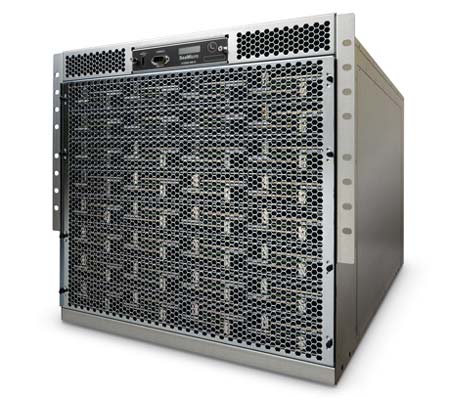
The SM-10000 server from startup SeaMicro, which can pack 512 Intel Atom CPUs into a 10U chassis.
When the Mozilla Corporation rolled out Firefox 4, the browser wasn't the only new technology making its debut. The launch was powered by new servers from SeaMicro that use about a quarter of the power and space of most commercial servers.
SeaMicro’s multi-core x86 server runs on Intel’s low-power Atom chips, whose energy efficiency has made them the processor of choice for many mobile phones and laptops. The company is one of several closely watched initiatives to adapt low-power processors in servers to help manage soaring power use in data centers. In its implementation at Mozilla, SeaMicro's claims were tested in a high-profile deployment.
"SeaMicro played a big role in the launch of Firefox 4,” said Justin Fitzhugh, the outgoing Vice President of Operations at Mozilla, who discussed Mozilla’s adoption of SeaMicro servers Thursday at The Uptime Symposium in Santa Clara, Calif.
Atom Servers Power Download Portal
Mozilla has been using SeaMicro's SM-10000 server to power its download portal, which redirects users to the many mirror sites for Firefox. Users have download more than 156 million copies of the browser since its official launch on March 22. SeaMicro gear also supported several microsites evangelizing the Firefox 4 launch on Twitter and other social networks.
During major Firefox launches, Mozilla’s network handles traffic spikes of up to 15 gigabits per second, according to Fitzhugh. "We get huge amounts of traffic,” said Fitzhugh, who said the SeaMicro servers handled the load with no difficultiesd.
Power as Number One Issue
Performance was crucial, but where the new hardware really delivered was on power efficiency. The SeaMicro production servers used just 0.02 watts of electricity per browser request, Fitzhugh said, compared to 0.17 watts per request for the HP C7000 blade servers they replaced.
“The number one thing we look at in our data center is power use,” said Fitzhugh. “I don't even look at square footage anymore. All I really care about is power. With SeaMicro, I can get a ton more compute into the same footprint. We also saw a much more stable pattern of response time.
"It was fantastic," said Fitzhugh. "It’s changing the way we think about compute."
More Than Just Atom Processors
SeaMicro was founded in 2007 and has developed a new server architecture combining low-power CPUs, compact motherboards and an interconnection and switching fabric. This approach allows SeaMicro to pack 512 Atom CPUs into a 10U form factor chassis, which uses about 2.5 kilowatts of power. The network fabric that links the 512 CPUs in the SM10000 can support Ethernet, Fibre Channel and data center Ethernet.
The basic building block of the SeaMicro system is a credit card-sized compute block, comprised of an Intel Atom CPU and its chipset, DRAM, and a custom SeaMicro ASIC (application specific integrated circuit). Eight of these compute blocks are aggregated on a 5×11 inch motherboard, and 64 of the motherboards fit into a 10U SeaMicro server.
Fitzhugh said Mozilla didn't need to make any customizations to its software to migrate to the SeaMicro hardware. "We didn’t make any changes at all to our application, and we didn't have any issues," he said.
Not Appropriate for All Workloads
But SeaMicro gear is not appropriate for every workload, or every application, he said.
"SeaMicro is ideal for Web traffic and analytics," said Fitzhugh. "We have it running in multiple data centers, and we've started using it for Hadoop workloads and load testing. But with anything that's single-threaded and needs a lot of memory, it's not going to be a great fit at all. If you focus the hardware and software to what you want to do, you get huge efficiencies."
"What we're seeing here is better matching of workloads to compute," said Andrew Feldman, the CEO of SeaMicro, who joined Fitzhugh for the Uptime presentation. Feldman said Mozilla got one of the first SeaMicro prototypes in June 2009, and has been working with beta version since June 2010. A case study of the Mozilla implementation is posted on the SeaMicro web site.
'Simplified Our Infrastructure'
"Each time you download one of the 10,000 Firefox plug ins, you are traversing SeaMicro equipment," Matthew Zeier, Director of Operations at Mozilla, said in the case study. "The SM10000 was easy to deploy, improved compute per unit power, and simplified our infrastructure by eliminating Ethernet switch ports and reducing management overhead."
“Our investment in SeaMicro has already paid tremendous dividends," said Fitzhugh. "We are drawing on the order of one-fifth the power per HTTP request, and using less than one-fourth the space. This has freed room in our power envelope, and space in our cages to increase the compute footprint, providing additional CPU cycles for our different users, while dramatically reducing our operating expenses.”
Fitzhugh, who recently left Mozilla to take a similar post at Jive Software, said Mozilla has been using two of the 10U SeaMicro units per rack in several of its facilities, where its average power density is about 6 kilowatts per rack. Mozilla has a high-density installation in Phoenix that could support denser implementations, he said. But Fitzhugh had no issues with the tradeoffs in packing more processors into a smaller footprint.
"When I tell people about this, they almost call bulls**t on me," said Fitzhugh. "It sounds too good to be true."




